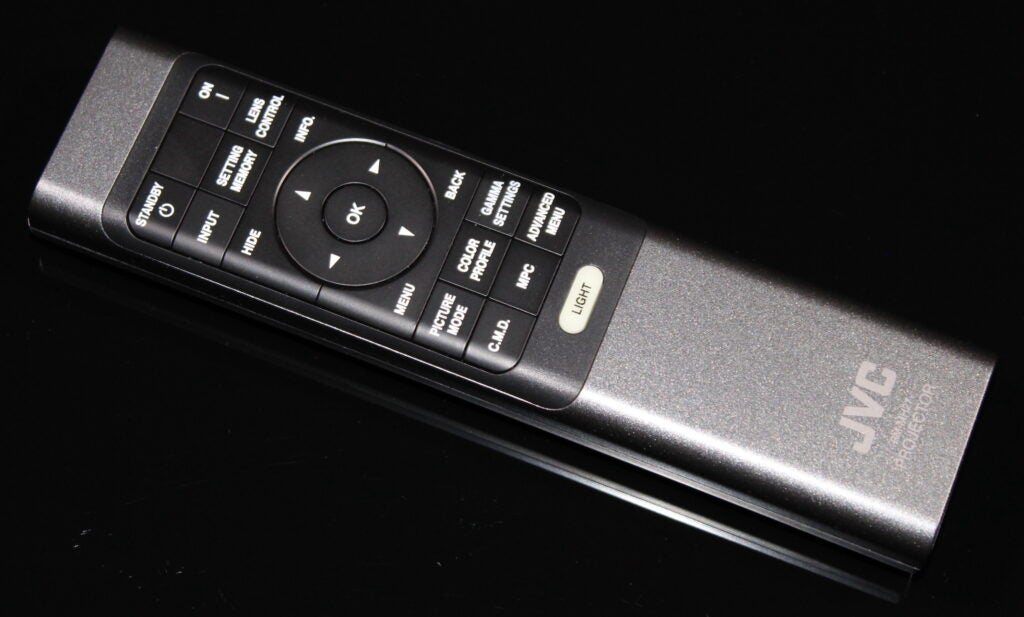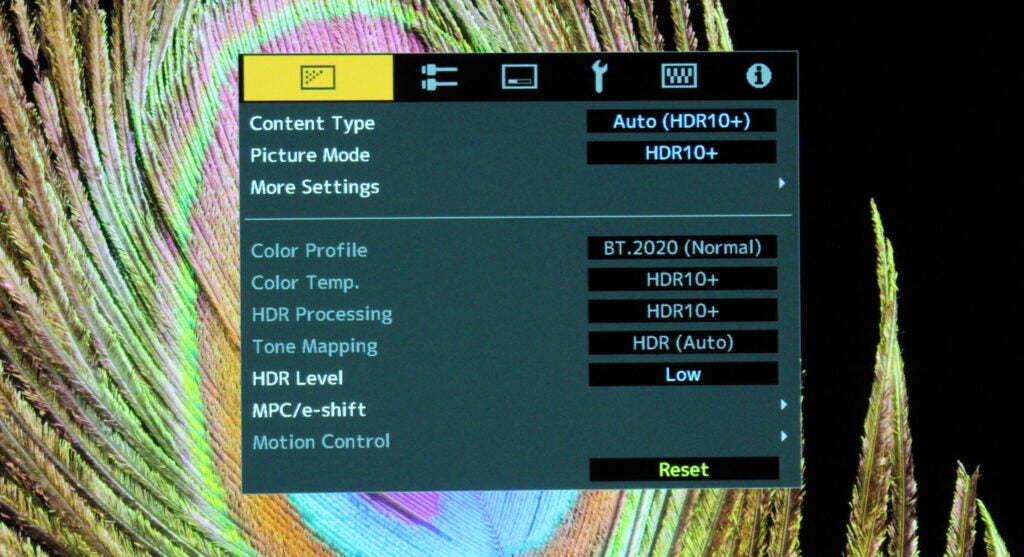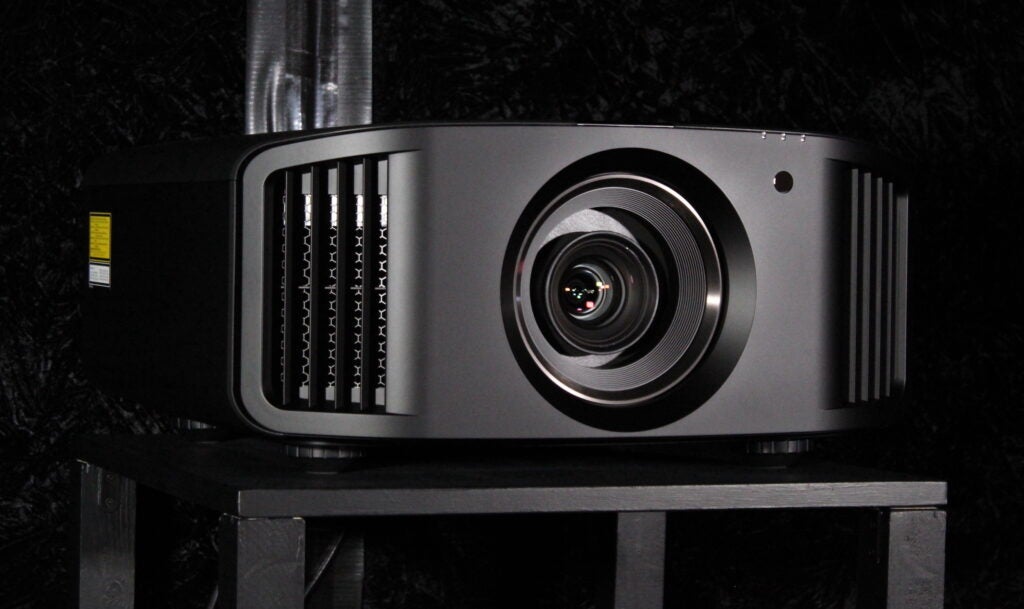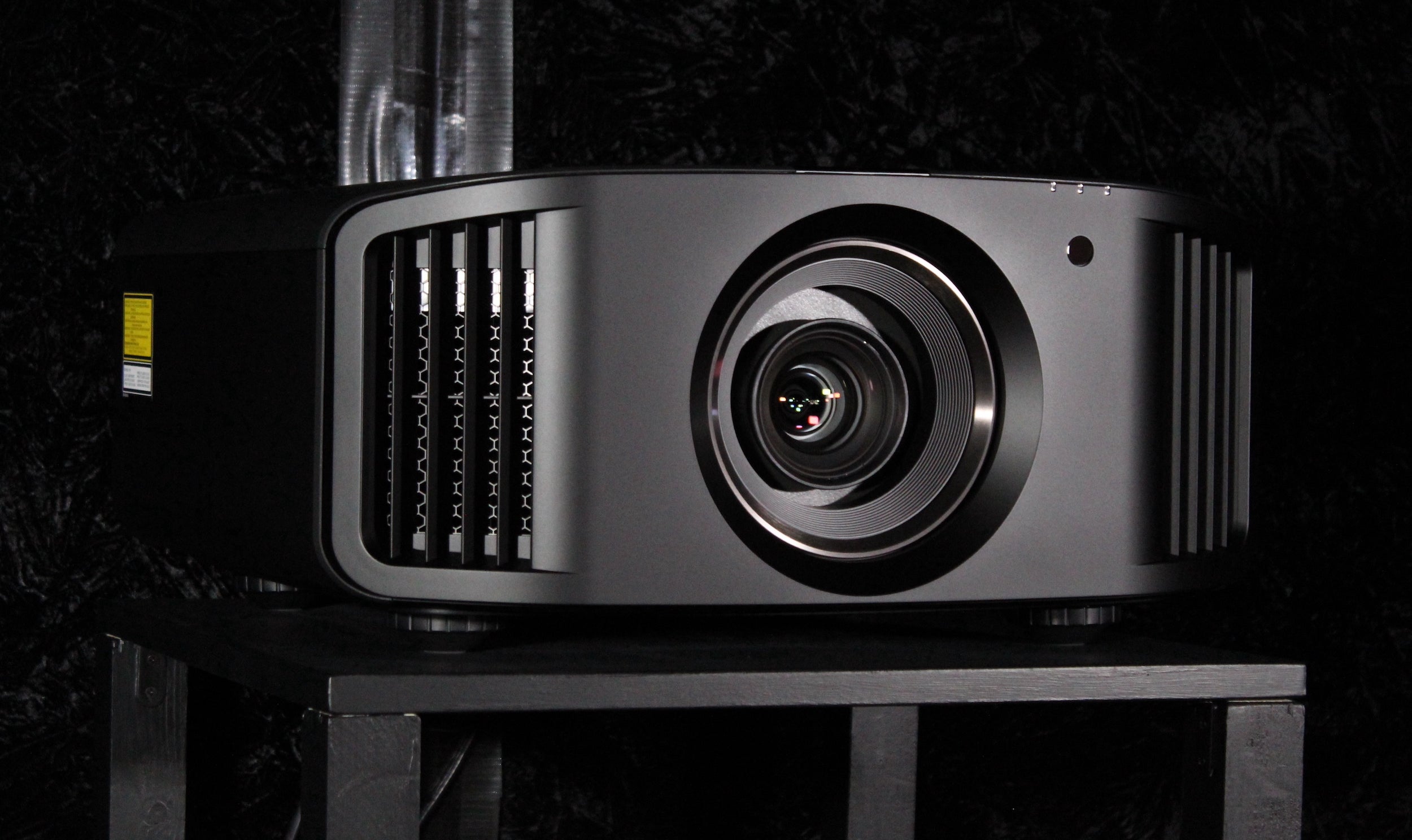Verdict
The JVC DLA-NZ7 is an impressive 4K projector that produces superb images thanks to class-leading blacks, state-of-the-art HDR tone-mapping, and cutting-edge 8K/e-shift processing. A laser light source delivers a 20,000 hour lifespan, while HDMI 2.1 inputs add extensive future proofing and next-gen gaming capabilities.
Pros
- Bright and punchy images
- Exceptional accuracy
- Excellent blacks and contrast
- Class-leading HDR performance
- Superb fit and finish
Cons
- Not exactly discreet
- Not cheap either
Availability
- UKRRP: £11499
- USARRP: $10999.95
- EuropeTBC
- CanadaRRP: CA$14499.99
- AustraliaTBC
-
Native 4KFull 4K (4096 x 2160) D-ILA chipset -
Laser light sourceBLU-Escent laser diode with a claimed brightness of 2,500 lumens and a lifespan of 20,000 hours -
Frame Adapt HDRDynamic tone mapping for a superior projected HDR experience -
Theatre OptimiserCustomise the projector’s HDR to your specific home cinema setup -
8K/e-shiftTwo-direction shift produces an 8K-quality image of 8192 x 4320 -
2 x HDMI 2.1 inputsThese support 8K/60, 4K/120, and HDR10+
Introduction
The JVC DLA-NZ7 is the ‘entry-level’ model in the brand’s new range of home cinema projectors, and boasts a BLU-Escsent laser light source that provides increased brightness compared to a lamp-based beamer, along with much improved image consistency, and a 20,000-hour lifespan.
Other key features include two-direction 8K/e-shift and HDMI 2.1, which means this projector supports 8K/60, 4K/120, and HDR10+ with dynamic metadata. Once you include impressive black levels and class-leading HDR tone mapping, you have a projector that sets the bar at its price point.
Design
- 65mm all-glass lens
- 2 x HDMI 2.1 inputs
- Backlit remote control
The JVC DLA-NZ7 uses exactly the same matte black chassis as the rest of JVC’s new laser-powered line-up. It’s extremely well-made and very big, measuring 500 x 234 x 505mm (WHD), and weighing in at 22.5kg. So this is isn’t the kind of projector you setup occasionally, and is aimed at more permanent custom installations.
The NZ7 uses the same 17-element, 15-group all-glass 65mm lens found on the more expensive DLA-NZ8, but lacks the coating on the inside of the light path that’s designed to suppress reflected light and improve the contrast ratios. However, it still has a claimed contrast ratio of 40,000:1, which is superior to any of JVC’s competition.
The two HDMI 2.1 inputs are 48Gbps ports that accept both 8K/60p and 4K/120p, plus they support HDCP 2.3, 3D and high dynamic range – specifically HDR10, HLG, and HDR10+. An added benefit of HDMI 2.1 is the NZ7’s ability to lock onto video signals faster than previous JVC projectors, which were often painfully slow at this.

The provided remote is identical to previous generations, and remains a well-designed controller that’s comfortable to hold and easy to use with one hand. The layout of the buttons is intuitive, and there’s a dedicated backlight that illuminates the actual writing on the buttons, making them much easier to read in the darkened room.
Features
- BLU-Escent laser light source
- 4K (4096 x 2160) D-ILA chipset
- 8K/e-shift image processing
- HDR Dynamic tone mapping
- Theatre Optimiser
The JVC DLA-NZ7 contains the company’s BLU-Escent laser diode light source first introduced on the ultra high-end DLA-Z1, and also used on the NZ8 and NZ9. This new light source results in increased brightness, improved consistency, and a 20,000-hour lifespan – so no obvious dimming over time and no need to change the lamp.
The NZ7 uses the 4K (4096 x 2160) D-ILA device that JVC introduced on its previous generation of projectors, and also uses the same 8K/e-shift processing first introduced on the DLA-NX9. Unlike the four-shift 8K/e-shiftX tech used on the NZ8 and NZ9, this version only shifts the pixels in two directions to display an image. While the perceived resolution is higher than 4K, it can’t hit the full 8192 x 4320 pixels produced by the four-shift approach.
Another difference when comparing the NZ7 to the NZ8 and NZ9 is that the former doesn’t have the wide colour gamut filter included with the two more expensive models. The downside is that the NZ7 can’t reach 100% of DCI-P3, but on the plus side the HDR is brighter without the filter cutting the light output by about 25%.

JVC’s HDR is class-leading, with Auto Tone Mapping that reads static metadata and adjusts accordingly. Frame Adapt HDR then analyses a signal and changes the tone mapping on the fly, while the Theatre Optimiser maximises the HDR delivery to best suit your particular screen size and gain.
There are motorised focus, zoom and shift controls, making installation a piece of cake, and lens memories for different aspect ratios. To reflect the increase in popularity of ‘Scope screens, the menu options in the Theatre Optimiser now allow you to specify if your screen uses a 16:9 or 2.35:1 aspect ratio.
The laser light source has three LD Power options (low, mid, and high), along with two Dynamic CTRL settings that dynamically adjust the brightness of the laser. The laser is surprisingly quiet in operation, even in the brighter mid option, while the high mode isn’t significantly louder either.
Performance
- Gorgeous HDR images
- Punchy highlights and colours
- Eye-popping 3D visuals
The JVC DLA-NZ7 delivers awesome native 4K images that render remarkable levels of detail while still retaining that all-important film-like quality for which JVC projectors are justly famous. The uniformity and geometry of the image is also excellent, ensuring this projector delivers bright and clean big screen pictures.
The greyscale and colour gamut are highly accurate, hitting the industry standards right out of the box. The blacks are also deep and rich, while the increased brightness ensures the picture really pops. The more expensive NZ8 might have a contrast ratio that’s double the NZ7’s 40,000:1, but unless you’re in a completely blacked out room, it’s unlikely you’ll notice the difference.
This motion handling is excellent, with smooth images free of blurring or unwanted artefacts like judder. The NZ7 is great with 24p film content, but also performs well with higher frame rates up to an including 120Hz for games. The processing is impressive, upscaling lower resolution content to 4K, and thanks to the HDMI 2.1 inputs and 8K/e-shift the NZ7 can even accept and display 8K content (if you can find any).
This projector is a first-class performer when it comes to SDR, producing images that are accurate, artefact-free, very bright and with excellent black levels. When it comes to HDR the performance is even better, with those deep blacks and bright highlights combining perfectly, while state-of-the-art tone mapping effectively renders HDR by not only taking full advantage of the format, but also optimising the pictures to the projector’s inherent strengths.
This is perfectly demonstrated in the opening of Morbius, where a cave full of vampire bats is beautifully rendered thanks to the excellent contrast and superb dynamic tone-mapping. The blacks are deep, but the shadows are also incredibly detailed, allowing you to make out all the bats hanging on the walls of the gloomy cave.

The NZ7 lacks the wide colour filter found on the NZ8 and NZ9, so it can’t reach 100% of the DCI-P3 colour space used for HDR content, but it still produces about 90%, leading to some some nicely saturated primary colours. This is demonstrated in Guardians of the Galaxy Vol.2 when our heroes arrive on Ego’s planet, and the landscape is riot of colours, all delivered with precision. It’s doubtful most people would ever notice the slightly smaller colour gamut.
The HDR10 performance is exceptional, but the NZ7’s support of HDR10+ allows this projector to take advantage of the format’s added dynamic metadata to deliver HDR images are often more precise because the added metadata allows the tone mapping to adjust on a scene-by-scene and even frame-by-frame basis.
The 4K Blu-ray of The Shining includes an HDR10+ option, and the native 4K scan brings out every detail in the original 35mm photography. The clarity is stunning, and the dynamic metadata of HDR10+ ensures that the blacks are deep, the shadows detailed, and the white snowy vistas are free of any clipping.
The 3D performance is equally fantastic, and the NZ7 delivers the extra dimensionality with images that are big, bright, accurate, and thankfully free of any ghosting. You’ll need to purchase the optional RF transmitter and glasses, but if you’re a 3D fan you won’t be disappointed by the results.
Finally, gamers will delighted to learn the input lag is only 38ms with low latency turned on, which is good for a projector. This results in enjoyably responsive big screen game play that is wonderfully immersive, and once you factor in the 4K/120p support and laser light source, the NZ7 makes an excellent choice for a gaming projector.
Latest deals
Should you buy it?
If you want lovely 4K images, impressive black levels and class-leading HDR, this is the projector for you. It’s similar to the more expensive NZ8 and quite a bit cheaper.
If you want something small and portable for occasional use, this isn’t the projector for you. It’s very big and heavy, plus it’s very expensive and mainly aimed at cinephiles.
Final Thoughts
This projector is so good, it’s hard to justify buying JVC’s more expensive but equally impressive NZ8. The NZ7 might not be quite as bright, it might not have as wide a colour gamut, and its contrast ratio isn’t as good, but most people won’t notice the differences and it’s four grand cheaper. Best of all you still get stunning native 4K images, class-leading HDR, 8K/e-shiftX processing, a long-life laser light source, and next-gen gaming features thanks to HDMI 2.1 inputs. The NZ7 remains a significant investment, but you won’t find a better performer at this price point.
How we test
We test every projector we review thoroughly over an extended period of time. We use industry standard tests to compare features properly. We’ll always tell you what we find. We never, ever, accept money to review a product.
Find out more about how we test in our ethics policy.
Tested for more than a week
Tested with real world use
FAQs
The NZ7 laser projector is capable of outputting at native 4K resolutions and requires using JVC’s e-Shift technology to produce an image close to 8K in 8192 x 4320 resolution.
Sustainability
Trusted Reviews’ holds the fact that global warming is not a myth as a core value and will continuously endeavour to help protect our planet from harm in its business practices.
As part of this mission, whenever we review a product we send the company a series of questions to help us gauge and make transparent the impact the device has on the environment.
We currently haven’t received answers to the questions on this product, but will update this page the moment we do. You can see a detailed breakdown of the questions we ask and why in our sustainability info page.
Jargon buster
Colour Gamut
The range of colours an output device is capable of reproducing.
Clipping
The loss of detail in the brightest part of an image
Judder
Judder is a visual phenomenon caused by inconsistency in the frame rate of video content
Verdict
The JVC DLA-NZ7 is an impressive 4K projector that produces superb images thanks to class-leading blacks, state-of-the-art HDR tone-mapping, and cutting-edge 8K/e-shift processing. A laser light source delivers a 20,000 hour lifespan, while HDMI 2.1 inputs add extensive future proofing and next-gen gaming capabilities.
Pros
- Bright and punchy images
- Exceptional accuracy
- Excellent blacks and contrast
- Class-leading HDR performance
- Superb fit and finish
Cons
- Not exactly discreet
- Not cheap either
Availability
- UKRRP: £11499
- USARRP: $10999.95
- EuropeTBC
- CanadaRRP: CA$14499.99
- AustraliaTBC
-
Native 4KFull 4K (4096 x 2160) D-ILA chipset -
Laser light sourceBLU-Escent laser diode with a claimed brightness of 2,500 lumens and a lifespan of 20,000 hours -
Frame Adapt HDRDynamic tone mapping for a superior projected HDR experience -
Theatre OptimiserCustomise the projector’s HDR to your specific home cinema setup -
8K/e-shiftTwo-direction shift produces an 8K-quality image of 8192 x 4320 -
2 x HDMI 2.1 inputsThese support 8K/60, 4K/120, and HDR10+
Introduction
The JVC DLA-NZ7 is the ‘entry-level’ model in the brand’s new range of home cinema projectors, and boasts a BLU-Escsent laser light source that provides increased brightness compared to a lamp-based beamer, along with much improved image consistency, and a 20,000-hour lifespan.
Other key features include two-direction 8K/e-shift and HDMI 2.1, which means this projector supports 8K/60, 4K/120, and HDR10+ with dynamic metadata. Once you include impressive black levels and class-leading HDR tone mapping, you have a projector that sets the bar at its price point.
Design
- 65mm all-glass lens
- 2 x HDMI 2.1 inputs
- Backlit remote control
The JVC DLA-NZ7 uses exactly the same matte black chassis as the rest of JVC’s new laser-powered line-up. It’s extremely well-made and very big, measuring 500 x 234 x 505mm (WHD), and weighing in at 22.5kg. So this is isn’t the kind of projector you setup occasionally, and is aimed at more permanent custom installations.
The NZ7 uses the same 17-element, 15-group all-glass 65mm lens found on the more expensive DLA-NZ8, but lacks the coating on the inside of the light path that’s designed to suppress reflected light and improve the contrast ratios. However, it still has a claimed contrast ratio of 40,000:1, which is superior to any of JVC’s competition.
The two HDMI 2.1 inputs are 48Gbps ports that accept both 8K/60p and 4K/120p, plus they support HDCP 2.3, 3D and high dynamic range – specifically HDR10, HLG, and HDR10+. An added benefit of HDMI 2.1 is the NZ7’s ability to lock onto video signals faster than previous JVC projectors, which were often painfully slow at this.

The provided remote is identical to previous generations, and remains a well-designed controller that’s comfortable to hold and easy to use with one hand. The layout of the buttons is intuitive, and there’s a dedicated backlight that illuminates the actual writing on the buttons, making them much easier to read in the darkened room.
Features
- BLU-Escent laser light source
- 4K (4096 x 2160) D-ILA chipset
- 8K/e-shift image processing
- HDR Dynamic tone mapping
- Theatre Optimiser
The JVC DLA-NZ7 contains the company’s BLU-Escent laser diode light source first introduced on the ultra high-end DLA-Z1, and also used on the NZ8 and NZ9. This new light source results in increased brightness, improved consistency, and a 20,000-hour lifespan – so no obvious dimming over time and no need to change the lamp.
The NZ7 uses the 4K (4096 x 2160) D-ILA device that JVC introduced on its previous generation of projectors, and also uses the same 8K/e-shift processing first introduced on the DLA-NX9. Unlike the four-shift 8K/e-shiftX tech used on the NZ8 and NZ9, this version only shifts the pixels in two directions to display an image. While the perceived resolution is higher than 4K, it can’t hit the full 8192 x 4320 pixels produced by the four-shift approach.
Another difference when comparing the NZ7 to the NZ8 and NZ9 is that the former doesn’t have the wide colour gamut filter included with the two more expensive models. The downside is that the NZ7 can’t reach 100% of DCI-P3, but on the plus side the HDR is brighter without the filter cutting the light output by about 25%.

JVC’s HDR is class-leading, with Auto Tone Mapping that reads static metadata and adjusts accordingly. Frame Adapt HDR then analyses a signal and changes the tone mapping on the fly, while the Theatre Optimiser maximises the HDR delivery to best suit your particular screen size and gain.
There are motorised focus, zoom and shift controls, making installation a piece of cake, and lens memories for different aspect ratios. To reflect the increase in popularity of ‘Scope screens, the menu options in the Theatre Optimiser now allow you to specify if your screen uses a 16:9 or 2.35:1 aspect ratio.
The laser light source has three LD Power options (low, mid, and high), along with two Dynamic CTRL settings that dynamically adjust the brightness of the laser. The laser is surprisingly quiet in operation, even in the brighter mid option, while the high mode isn’t significantly louder either.
Performance
- Gorgeous HDR images
- Punchy highlights and colours
- Eye-popping 3D visuals
The JVC DLA-NZ7 delivers awesome native 4K images that render remarkable levels of detail while still retaining that all-important film-like quality for which JVC projectors are justly famous. The uniformity and geometry of the image is also excellent, ensuring this projector delivers bright and clean big screen pictures.
The greyscale and colour gamut are highly accurate, hitting the industry standards right out of the box. The blacks are also deep and rich, while the increased brightness ensures the picture really pops. The more expensive NZ8 might have a contrast ratio that’s double the NZ7’s 40,000:1, but unless you’re in a completely blacked out room, it’s unlikely you’ll notice the difference.
This motion handling is excellent, with smooth images free of blurring or unwanted artefacts like judder. The NZ7 is great with 24p film content, but also performs well with higher frame rates up to an including 120Hz for games. The processing is impressive, upscaling lower resolution content to 4K, and thanks to the HDMI 2.1 inputs and 8K/e-shift the NZ7 can even accept and display 8K content (if you can find any).
This projector is a first-class performer when it comes to SDR, producing images that are accurate, artefact-free, very bright and with excellent black levels. When it comes to HDR the performance is even better, with those deep blacks and bright highlights combining perfectly, while state-of-the-art tone mapping effectively renders HDR by not only taking full advantage of the format, but also optimising the pictures to the projector’s inherent strengths.
This is perfectly demonstrated in the opening of Morbius, where a cave full of vampire bats is beautifully rendered thanks to the excellent contrast and superb dynamic tone-mapping. The blacks are deep, but the shadows are also incredibly detailed, allowing you to make out all the bats hanging on the walls of the gloomy cave.

The NZ7 lacks the wide colour filter found on the NZ8 and NZ9, so it can’t reach 100% of the DCI-P3 colour space used for HDR content, but it still produces about 90%, leading to some some nicely saturated primary colours. This is demonstrated in Guardians of the Galaxy Vol.2 when our heroes arrive on Ego’s planet, and the landscape is riot of colours, all delivered with precision. It’s doubtful most people would ever notice the slightly smaller colour gamut.
The HDR10 performance is exceptional, but the NZ7’s support of HDR10+ allows this projector to take advantage of the format’s added dynamic metadata to deliver HDR images are often more precise because the added metadata allows the tone mapping to adjust on a scene-by-scene and even frame-by-frame basis.
The 4K Blu-ray of The Shining includes an HDR10+ option, and the native 4K scan brings out every detail in the original 35mm photography. The clarity is stunning, and the dynamic metadata of HDR10+ ensures that the blacks are deep, the shadows detailed, and the white snowy vistas are free of any clipping.
The 3D performance is equally fantastic, and the NZ7 delivers the extra dimensionality with images that are big, bright, accurate, and thankfully free of any ghosting. You’ll need to purchase the optional RF transmitter and glasses, but if you’re a 3D fan you won’t be disappointed by the results.
Finally, gamers will delighted to learn the input lag is only 38ms with low latency turned on, which is good for a projector. This results in enjoyably responsive big screen game play that is wonderfully immersive, and once you factor in the 4K/120p support and laser light source, the NZ7 makes an excellent choice for a gaming projector.
Latest deals
Should you buy it?
If you want lovely 4K images, impressive black levels and class-leading HDR, this is the projector for you. It’s similar to the more expensive NZ8 and quite a bit cheaper.
If you want something small and portable for occasional use, this isn’t the projector for you. It’s very big and heavy, plus it’s very expensive and mainly aimed at cinephiles.
Final Thoughts
This projector is so good, it’s hard to justify buying JVC’s more expensive but equally impressive NZ8. The NZ7 might not be quite as bright, it might not have as wide a colour gamut, and its contrast ratio isn’t as good, but most people won’t notice the differences and it’s four grand cheaper. Best of all you still get stunning native 4K images, class-leading HDR, 8K/e-shiftX processing, a long-life laser light source, and next-gen gaming features thanks to HDMI 2.1 inputs. The NZ7 remains a significant investment, but you won’t find a better performer at this price point.
How we test
We test every projector we review thoroughly over an extended period of time. We use industry standard tests to compare features properly. We’ll always tell you what we find. We never, ever, accept money to review a product.
Find out more about how we test in our ethics policy.
Tested for more than a week
Tested with real world use
FAQs
The NZ7 laser projector is capable of outputting at native 4K resolutions and requires using JVC’s e-Shift technology to produce an image close to 8K in 8192 x 4320 resolution.
Sustainability
Trusted Reviews’ holds the fact that global warming is not a myth as a core value and will continuously endeavour to help protect our planet from harm in its business practices.
As part of this mission, whenever we review a product we send the company a series of questions to help us gauge and make transparent the impact the device has on the environment.
We currently haven’t received answers to the questions on this product, but will update this page the moment we do. You can see a detailed breakdown of the questions we ask and why in our sustainability info page.
Jargon buster
Colour Gamut
The range of colours an output device is capable of reproducing.
Clipping
The loss of detail in the brightest part of an image
Judder
Judder is a visual phenomenon caused by inconsistency in the frame rate of video content
























